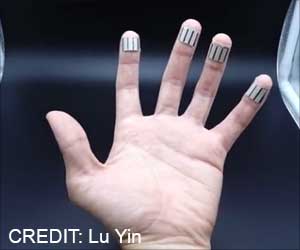There were many similar devices in the past where most of them required intense physical activities by the user. This device cancels out such needs by making use of our sweaty fingers to power some small wearable electronics during sleep.
‘Lactate is a metabolic by-product excreted in sweat. The new bio enzyme-based power generators produce energy using this molecule by a series of chemical reactions.’
“Normally, you want maximum return on investment in energy. You don’t want to expend a lot of energy through exercise to get only a little energy back. But here, we wanted to create a device adapted to daily activity that requires almost no energy investment. You can completely forget about the device and go to sleep or do desk work like typing, yet still continue to generate energy. You can call it ‘power from doing nothing,” said Joseph Wang, senior author of the study.
Biofuel cell that uses lactate
The novel device was designed based on the concept of a biofuel cell (BFC). A foam made of carbon nanotube material and some hydrogel components make this device unique. The product contains a bio enzyme that acts upon the lactate molecules present in our sweat. Once the enzyme comes into contact with the sweat, electrons are removed from the lactate molecules and a series of biochemical reactions occur, creating a current of electricity.
This setup does not cause any inconvenience to the users. “The size of the device is about one centimeter squared. Its material is flexible as well, so you don’t need to worry about it being too rigid or feeling weird. You can comfortably wear it for an extended period of time,” said Yin, a nanoengineering Ph.D. student working in Wang’s lab.
Improved efficacy with add-ons
The team tested the efficacy of the product after adding piezoelectric generators that convert mechanical energy into electricity. It helped to harvest up to 20% additional energy. The new design was also capable of generating power to run vitamin C- and sodium-sensing systems.
Apart from this, the team is keen to improve their design further to make it suitable for health and wellness applications such as glucose meters. “We want to make this device more tightly integrated in wearable forms, like gloves. We’re also exploring the possibility of enabling wireless connections to mobile devices for extended continuous sensing. There’s a lot of exciting potential. We have ten fingers to play with,” highlighted Yin.
Source: Medindia



